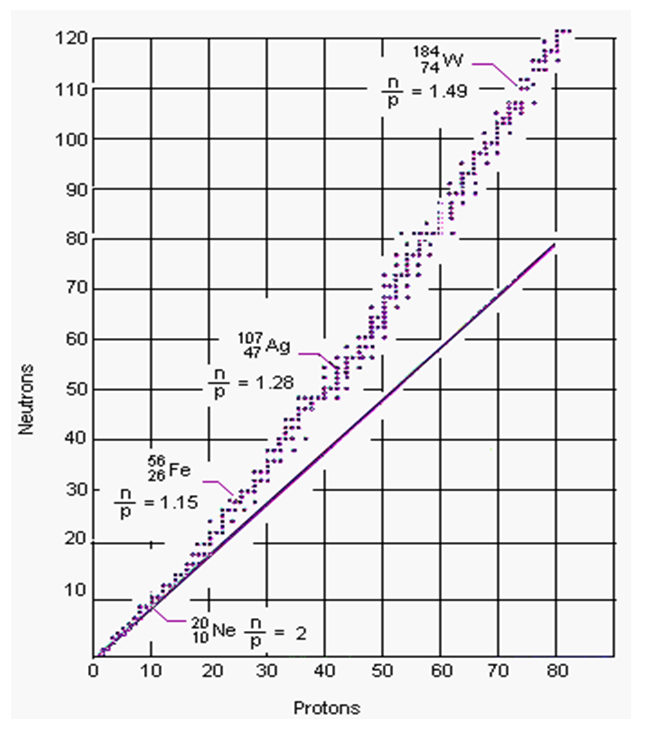In the periodic table, a Hydrogen nucleus has one proton surrounded by one electron. A Helium nucleus has two protons and two electrons and it also has two neutrons but no-one knows why. Each higher element has not only one more proton and electron but also one or more neutrons, so:
“… all the stable nuclei have more neutrons than protons (or equal numbers), and the heavier nuclei are increasingly neutron-rich.” (Marburger, 2011) p254

For some reason, heavier nuclei need more neutrons to be stable (Figure 4.22) but no theory can explain how neutrons keep the nucleus stable. The shell model that explains electrons doesn’t work because some nuclei aren’t spherical. The standard model doesn’t help because if gluons hold the protons together, why have neutrons? And how do the gluons know how many neutrons are needed to stabilize a heavy nucleus? Current nuclear models generally represent the nucleus as proton and neutrons sitting side-by-side with gluons forcing the protons together, like fruits in a bowl.
The quark structure given earlier describes protons and neutrons as quarks sharing photons in a closed triangle string. This allows such triangles to open up and recombine in longer quark strings if the same rules are satisfied: namely a closed string shape with the internal angles of an equilateral triangle.
This suggests that a Helium nucleus isn’t proton and neutron particles sitting separately together like fruit in a bowl but a single quark string that closes back on itself made from the quarks of two protons and two neutrons sharing photons.
The fruit-bowl model sees a Helium nucleus as separate proton and neutron particles just sitting together but a quark string model sees the Helium nucleus as a single string held together as protons and neutrons are, by photon sharing. The only restriction is that each link must bend the string 60º which requires quarks to rotate to make a connection. Higher nuclei then also form in the same way.
The quark string model explains why neutrons are needed. As photon sharing needs direct proximity, a proton can’t come that close to another proton because they repel, so neutrons are needed as buffers. When the quark string nucleus forms, neutrons are needed in between same-charge protons that can’t exist side-by-side. This requires at least as many neutrons as protons, as observed, so a Helium nucleus of two protons needs two neutrons to act as buffers between the protons in the closed string.
Closed quark strings will be compact and nearly spheres, as observed, but larger nuclei may need more neutrons to avoid fold-back loci that happen to make protons adjacent. In this nuclear evolution certain shapes will be more stable:
“Nuclei with either protons or neutron equal to certain “magic” numbers (2, 8, 20, 28, 50, 82, 126) are particularly stable.” (Marburger, 2011) p253
If atomic nuclei are closed quark strings, those with a magic number of nucleons are more stable because they form the symmetric shapes that gave rise to magic numbers in the first place.
A quark string model explains the properties of atomic nuclei and why they need neutrons. In quantum realism, atomic nuclei are not bundles of protons and neutrons but are single closed quark strings that fold in space as proteins do.